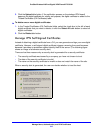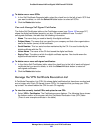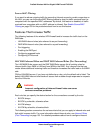
Network and System Management
324
ProSafe Wireless-N 8-Port Gigabit VPN Firewall FVS318N
- Single address. The rule applies to the address of a particular computer.
- Address range. The ru
le applies to a range of addresses.
- Group
s. The rule applies to a group of computers. (You can configure groups for LAN
WAN outbound rules but not for DMZ WAN outbound rules.) The Known PCs and
Devices table is an automatically maintained list of all known computers and network
devices and is generally referred to as the network database, which is described in
Manage the Network Database o
n page 68. Computers and network devices are
entered into the network database by various methods, which are described in
Manage IPv4 Groups and Hosts (IPv4 LAN Groups) o
n page 67.
• W
AN users. You can specify which Internet locations are covered by an outbound rule,
based on their IP address:
- Any.
The rule applies to all Internet IP address.
- Single a
ddress. The rule applies to a single Internet IP address.
- Address range. The ru
le applies to a range of Internet IP addresses.
• Schedul
e. You can configure three different schedules to specify when a rule is applied.
Once a schedule is configured, it affects all rules that use this schedule. You specify the
days of the week and time of day for each schedule. For more information, see Set a
Schedule to Block or Allow Specific Traffic on
page 182.
• QoS p
rofile. You can apply QoS profiles to outbound rules to regulate the priority of
traffic. For information about QoS profiles, see Preconfigured Quality of Service Profiles
on page 177.
• Bandwid
th profile. You can define bandwidth profiles and then apply them outbound
LAN WAN rules to limit traffic. (You cannot apply bandwidth profiles to DMZ WAN rules.)
For information about how to define bandwidth profiles, see Create Bandwidth Profiles on
page 175.
Content Filtering
If you want to reduce traffic by preventing access to certain sites on the Internet, you can use
the wireless VPN firewall’s content-filtering feature. By default, this feature is disabled; all
requested traffic from any website is allowed.
The wireless VPN firewall provides the following methods to filter web content in order to
reduce traf
fic:
• Keyword
blocking. You can specify words that, should they appear in the website name
(URL) or newsgroup name, cause that site or newsgroup to be blocked by the wireless
VPN firewall.
• W
eb object blocking. You can block the following web component types: embedded
objects (ActiveX and Java), proxies, and cookies.
To further narrow down the content filtering, you can configure groups to which the
con
tent-filtering rules apply and trusted domains for which the content-filtering rules do not
apply.


















